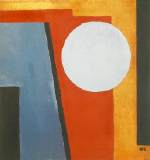

Activism, an avant-garde movement in Hungary, was marked by joint attempts of literature and fine arts. Its establishment is related to Lajos Kassák who invited progressive artists, philosophers and writers to work for A Tett (The Action, the name indicates that the journal was closely related to the German Die Aktion) published in 1915-16, and later for the journal MA when A TETT was banned. Its mentality related to major foreign avant-garde journals: similarly to the wish to reform society, it attempted to change arts radically.
The activists had far more radical views on society and arts than the group of The Eight without a uniform program. "The journal MA does not want to establish a new art school, but a completely new art and world conception," wrote Iván Hevesy, the art critic of the journal. Thus, it was not surprising that the activists took part in reforming art during the short life of the Hungarian Soviet Republic in 1919. Of members of the Eights, Lajos Tihanyi joined the MA and painted one of his best portraits of Lajos Kassák (Portrait of Lajos Kassák, 1918). Kassák and Béla Uitz, his brother-in-law, were decisive personalities of activism. Both of them went to the artist colony of Kecskemét in 1916 where they were particularly influenced by the cubist art of János Kmetty and Vilmos Perlrott-Csaba (János Kmetty: Kecskemét, 1912, Ascension, 1913). The journal MA published several pictures of Kmetty in reproduction. From the 1920s onwards, Kassák, besides being a significant writer and poet, became known as a representative of picture architecture, a novel esthetics based on pure geometric forms.
After the suppression of the Hungarian Soviet Republic, Hungarian emigrants in Vienna, Berlin and Moscow tried to continue the art program developed during World War I. Béla Uitz who produced posters (Red Soldiers, Forward!) and revolutionary panneaus was forced to leave the country and lived in Vienna, Paris and later in Moscow. Inspired by Russian constructivist traditions, he produced Icon Analysis, his major work, in 1922. József Nemes Lampérth first emigrated to Berlin, then, invited by a Swedish collector, worked in Sweden. After Self-Portrait (1911), his pictures were painted in stripes characteristic of his style. His obstinate uncompromising life-style ranked him as one of the most original progressive painters (Female Nude Standing with Back, 1916). After 1920 János Máttis Teutsch from Brassó was also forced to leave Hungarian art life. Retaining the delicate composition of his early works (Sunflowers), he developed an abstract, yet emotional style (Flowers of the Soul) which was related to the style represented by the German journal Sturm. Sándor Bortnyik published mainly illustrations in MA and carried on with graphic art during the emigration (Pages in MA Album, 1921). In his pictures he endeavoured to present metaphysical space where puppets of the mechanical age were heroes (The New Adam, The New Eve, 1924).